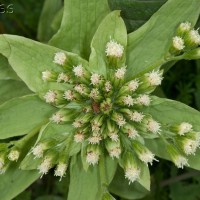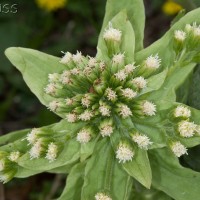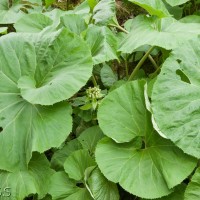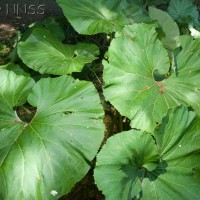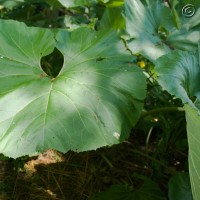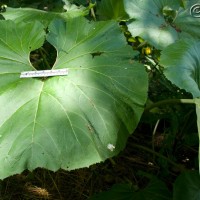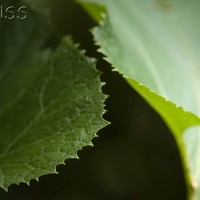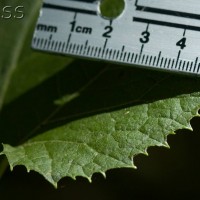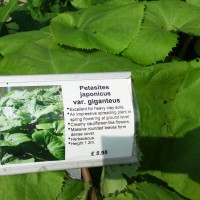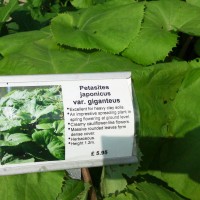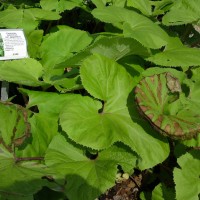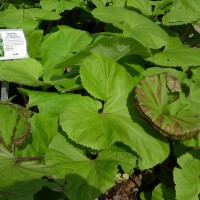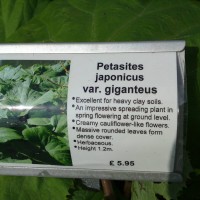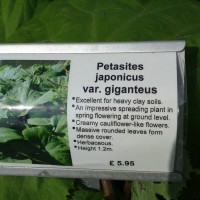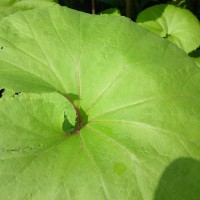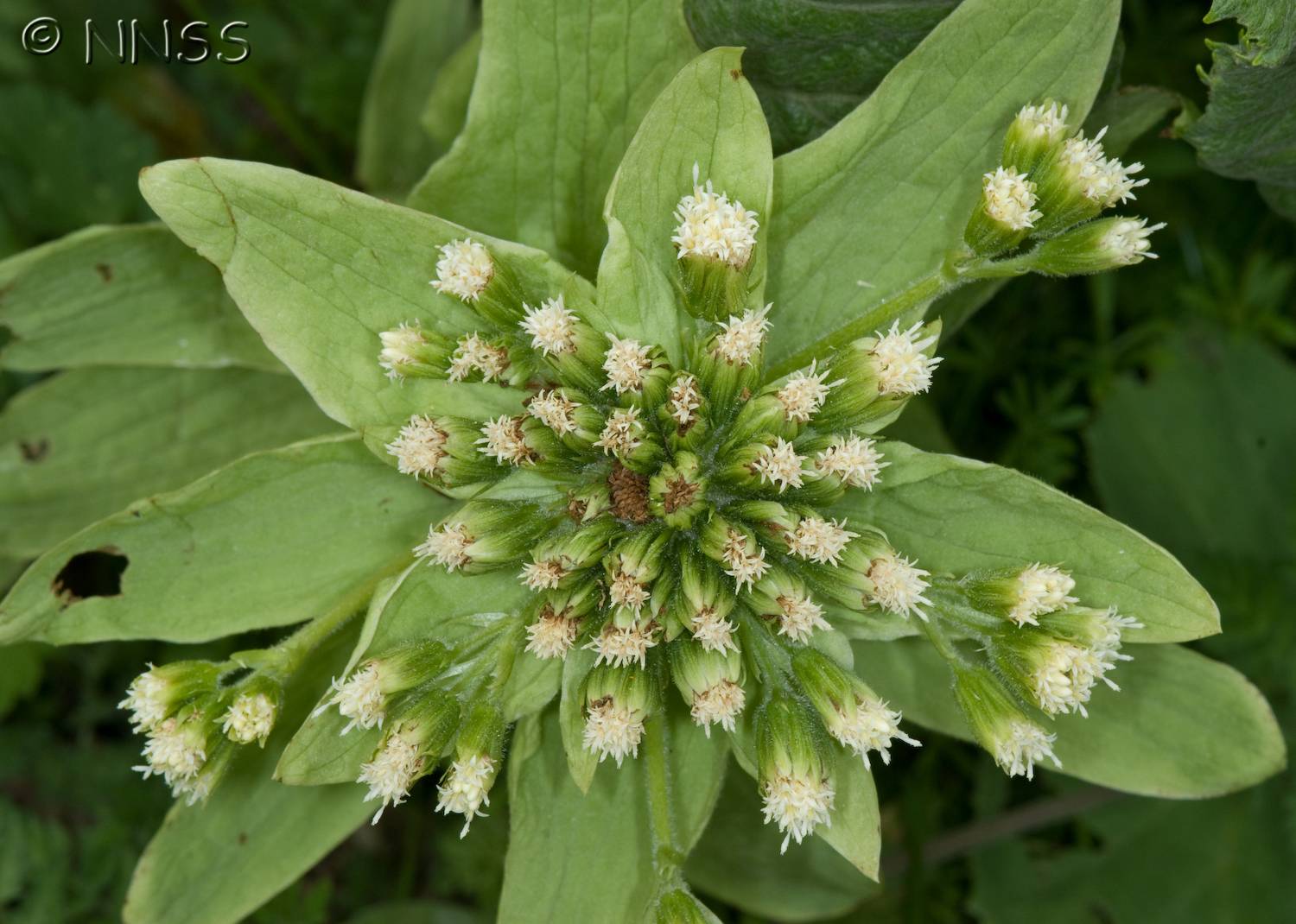
Giant Butterbur - Petasites japonicus
Expand and collapse the sections below by clicking on the title or + / - icons.
Short description of Petasites japonicus, Giant Butterbur
Shoots arise from a stout rhizome and may reach 2m high. It is a perennial herb and dies back in winter. Leaves are 30 – 100cm across, kidney-shaped, rough-textured and usually dark green. The lower leaf surface bears matted hairs. Plants are dioecious and bear stout flowering stems 30-120 cm high with many creamy-white fragrant flowers in spring before the leaves develop. It can form extensive single-sex colonies in suitable damp shady places.
Impact summary: Petasites japonicus, Giant Butterbur
Where the plant has naturalised in semi-natural situations (such as on riverbanks) it out-competes native plants, alters ecosystems and reduces diversity.
Habitat summary: Petasites japonicus, Giant Butterbur
It is found in shady, permanently damp places including river banks and plantation woodland.
Overview table
| Environment | Terrestrial |
|---|---|
| Species status | Non-Native |
| Native range | China, Kazan-retto, Nansei-shoto, Ogasawara-shoto, North Korea, South Korea, Sakhalin |
| Functional type | Land plant |
| Status in England | Non-Native |
| Status in Scotland | Non-Native |
| Status in Wales | Non-Native |
| Location of first record | v.c.24 (Denham) |
| Date of first record | 1924 |
Origin
It is native to Japan, Korea, NE China, Sakhalin and the Kuril Islands.
First Record
It was reported from Buckinghamshire in 1924.
Pathway and Method
First imported for planting in damp situations in gardens by 1897, it is a highly architectural ornamental herb. Naturalised populations in Britain are subspecies giganteus which so far consist almost exclusively of male plants. It can quickly outgrow its garden situation and most naturalised populations are the results of garden throw-outs or escapes. When it grows along stream and rivers it can spread downstream by means of rhizome fragments carried by the water.
Species Status
It is introduced and naturalised in scattered localities across the British Isles. By 1999 it had been recorded in 149 10km grid squares, with more than 70% of the populations recorded between 1987 and 1999. Conversely, it was very rare naturalised (14 10km grid squares) before 1970. It continues to spread slowly. It is also naturalised in Europe; in Belgium, Denmark, Finland, Norway and Sweden and at least Oregon and Washington in the United States.
Dispersal Mechanisms
Dispersal of naturalised plants appears to occur exclusively via vegetative means. It spreads via an extensive rhizome network and pieces of rhizome have the potential to form new colonies if moved from the parent plant. The dispersal mechanisms in Britain are poorly documented but it seems probable that plants growing along watercourses can spread via fragments of rhizome detached and carried downstream, or movement of soil containing the rhizomes could disperse the plant.
Reproduction
Plants are dioecious, consisting of separate male and female plants which are not self-fertile. Plants bear flowers in March and April – these are probably pollinated by bees and other insects. Later, if fertilised, female plants bear cylindrical seeds with a fringe of long hairs. As the vast majority of naturalised populations in Britain consist entirely of male plants sexual reproduction rarely, if ever takes place.
Known Predators/Herbivores
It has no known predators or herbivores in Britain. In cultivation in Japan, plants have been infected by arabis mosaic virus, butterbur mosaic virus and cucumber mosaic virus.
Resistant Stages
Rhizomes are tough and difficult to eradicate once well-established.
Habitat Occupied in GB
The plant is naturalised by rivers, roadsides, in plantations and other damp shady places in the lowlands.
Scattered throughout Britain, but scarce in eastern England and upland areas. It is very rare in Ireland.
Environmental Impact
Mature plants can reach 2m tall and produce enormous leaves which block out light and suppress native vegetation. Rhizomatous growth can be rapid, enabling large single-clone populations to establish quickly and significantly alter existing ecosystems. It is also thought that the rhizomes may produce alleopathic substances which inhibit the growth of other species near the colony.
Health and Social Impact
In oriental medicine extracts of giant butterbur have been used to treat asthma, oxidant stress and gastric ulcers. The spring growth has a bittersweet flavour and is valued in Japan as a vegetable at festive occasions. However, plants also contain pyrrolizidine alkaloids which have been linked to liver damage and cancerous tumours.
Economic Impact
There is no information about economic impacts of giant butterbur but its removal is likely to incur significant costs to landowners and waterways managers.
Identification
Sell P. & Murrell G. (2006) Flora of Great Britain and Ireland: Volume 4: Campanulaceae to Asteraceae, Cambridge University Press.
Stace, C.A. (2010) New flora of the British Isles, Third Edition, Cambridge University Press, Cambridge.
Biology, ecology, spread, vectors
Hind, N. & Kay, J. (2006) A nature print of Petasites japonicus subspecies giganteus. www.aseanbiodiversity.info
Preston, C.D., Pearman, D.A. & Dines, T.D. (2002) New Atlas of the British and Irish Flora, Oxford University Press, Oxford.
Distribution map from DAISIE European Invasive Alien Species Gateway: www.europe-aliens.org
Distribution map from the NBN Gateway: www.searchnbn.net/searchengine/search.jsp?tab=1&pg=1&searchTerm=Petasites+japonicus
Management and impact
Mount Baker – Snoquamie National Forest Amendment of Solicitation/ Modification of Contract: www.fs.fed.us/gpnf/purchasing/solicitations/documents/amend1.pdf
General
Grenfell, A.L. (1984) Aliens and Adventives: Petasites japonicus. BSBI News, 38, 13.
Iwamato, Y. (2009) Breeding of Japanese butterbur (Petasites japonicus) by using flowerhead culture. Plant Biotechnology, 26, 189-196.
General background information from Wikipedia: www.en.wikipedia.org
Plants for a Future: www.pfaf.org
Spotted this species?
Distribution map
View the Distribution map for Giant Butterbur, Petasites japonicus from BSBI

Native range map
View an interactive native range map for Giant Butterbur, Petasites japonicus

